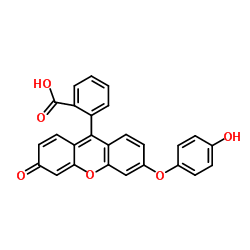359010-69-8
| Name | 3'-hydroxy-6'-(4-hydroxyphenoxy)spiro[2-benzofuran-3,9'-xanthene]-1-one |
|---|---|
| Synonyms |
ROS Probe,HPF
Hydroxyphenyl Fluorescein 2-[6-(4-Hydroxyphenoxy)-3-oxo-3H-xanthen-9-yl]benzoic acid Benzoic acid, 2-[6-(4-hydroxyphenoxy)-3-oxo-3H-xanthen-9-yl]- |
| Description | Hydroxyphenyl fluorescein (HPF) is the reagent that can directly detect highly reactive oxygen species (hROS). Hydroxyphenyl fluorescein selectively and dose-dependently reacts with hROS, such as the hydroxyl radical and peroxynitrite, which exhibit strong fluorescence[1][2]. |
|---|---|
| Related Catalog | |
| In Vitro | The fluorescence of Hydroxyphenyl Fluorescein (HPF) is greatly enhanced following incubation with blue light illuminated blebbistatin (30 min). Fluorescence enhancement of Hydroxyphenyl Fluorescein occurred equally efficiently under Ar purged and non-Ar purged conditions, suggesting that singlet oxygen as an intermediate involved is improbable. Fluorescence measurement with Hydroxyphenyl Fluorescein suggests a negative linear relationship between fluorescence intensity of Hydroxyphenyl Fluorescein (10 μM) and thiourea concentration (0-1 mM)[1]. |
| In Vivo | The Hydroxyphenyl Fluorescein (HPF) probe (15 μl, 25 μM) is given intratesticularly in anaesthetized mice 20 min before IR (ionizing radiation). The accumulation of •OH by the fluorescence signal emitted by the oxidized form of HPF is assessed[3]. |
| References |
| Density | 1.5±0.1 g/cm3 |
|---|---|
| Boiling Point | 709.9±60.0 °C at 760 mmHg |
| Molecular Formula | C26H16O6 |
| Molecular Weight | 424.402 |
| Flash Point | 249.8±26.4 °C |
| Exact Mass | 424.094696 |
| PSA | 85.22000 |
| LogP | 4.59 |
| Vapour Pressure | 0.0±2.4 mmHg at 25°C |
| Index of Refraction | 1.755 |
